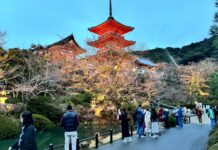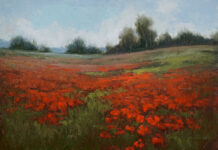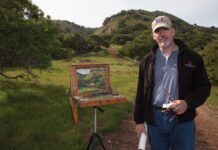By Lori Putnam
In this series, artist Lori Putnam speaks on the role artists can play in the conservation and preservation of land, cultures, and buildings. In this installment, Putnam explores the history, meaning, and value of the National Park System.
Lead Image: “The Grand Canyon of Yellowstone,” by Thomas Moran, 1893-1901, oil, 7 x 12 feet. Collection of the Smithsonian American Art Museum, Washington, DC
You would have to live under a rock to not know that this year marks the 100th birthday of our National Park Service. Social media, print media, radio, and television sources have provided us with plenty of images, heartwarming stories, and the like. As artists, most of us have painted in one national park or another. Or have we?
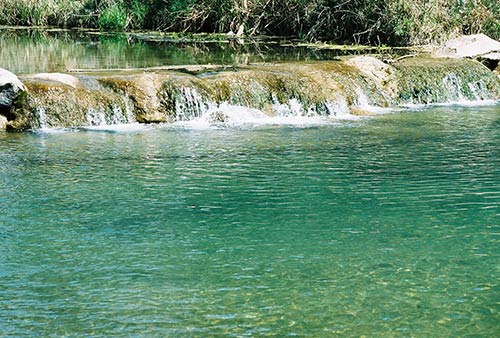
First, a little history of our National Parks Service (NPS), not to be confused with the National Park System (also NPS), which includes the properties managed by the service. The system of parks actually began when President Ulysses S. Grant signed an act making Yellowstone National Park our nation’s first, in 1872. Congress created 15 national parks well before it even thought to establish a dedicated service in 1916 to care for them. So, in effect, we have actually been celebrating President Woodrow Wilson’s act that created the National Park Service, not the parks themselves.
The idea for the parks themselves has been credited to the artist George Catlin. As he traveled the Great Plains of the United States, his concerns about destruction of the natural wilderness and Indian civilization prompted him to write, “by some great protecting policy of government… in a magnificent park… a nation’s park, containing man and beast, in all the wild[ness] and freshness of their nature’s beauty!”
Followed by poets and artists such as Henry David Thoreau and Thomas Cole, the majestic West spurred interest in preservation for the benefit of mankind to be “held for public use, resort, and recreation,” inalienable for all time, as said in a 2004 Department of the Interior publication. From these early days of our westward expansion, artists worked alongside explorers and scientists to document unfamiliar, awe-inspiring places and share their findings. In 1903, Frederick S. Dellenbaugh’s series of paintings brought the marvels of Zion Canyon to visitors to the St. Louis World’s Fair. Howard Russell Butler’s pieces a few years later traveled the entire country. This and other historic works belong to the Zion Museum Collection. They are exhibited in rotation with artists of today whose paintings are also contributing to public appreciation.
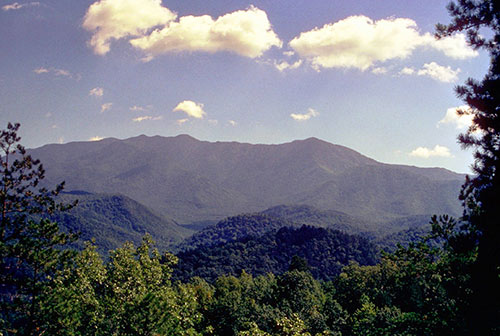
Following a reorganization in 1933, national parks, monuments, cemeteries, memorials, others were consolidated into a single National Park System. Before the reorganization, the system’s areas numbered just 67. This dramatic increase to 137, along with the need for new American employment opportunities, prompted President Franklin D. Roosevelt to institute the Civilian Conservation Corps, part of the New Deal, in 1935. The CCC employed more than 120,000 (at a time when America needed it most). Even more areas of our nation were added to the park system, including national historic sites, recreation areas, parkways, and seashores, among others. As of August 2016, there are 413 official “units” of the National Park System. These units protect, study, and manage more than 400 endangered species. This number does not even include all of the National Wildlife Refuges. However, only 58 of the official units are currently designated as actual National Parks.
Take, for example, a relatively small, mineral-rich sulfur spring in Oklahoma. Once known as Platt National Park, it was combined with surrounding lands, and is now known as the Chickasaw National Recreation Area. The Chickasaw and Choctaw tribes once gathered here to heal their minds, bodies, and souls in the stream. In the 1930s, folks visited the springs for many of the same reasons, and to free their thoughts briefly from stock market worries, the Great Depression, and high unemployment. The park did well through the 1950s (as most war-weary families began to enjoy more leisure activities and vacations). But Platt had none of the majesty of a Mount Rainier, and neither did it draw the elite class who helped form the Corps in the first place; it was seemingly too small and ordinary. The CCC planted trees and shrubs, and transplanted bison into the area to “improve it.” Environmental movements of the 1960s and the idea to invest in more “inspiring” wilderness resulted in Platt, along with a handful of other national parks, being demoted to recreation areas in 1976. Does that make it less enjoyable to those who visit today, change the spring’s mystical healing effects, or make it a less desirable painting subject? Or course not.
When it comes to sharing nature’s strength and grandeur with others, artists today are just as important as the Hudson River School artists whose vision helped start all of this in the first place. Today, however, even while visiting an official national park, one can easily confuse, even cross, lines between national and state parks, forests, preserves, and wildlife refuges in a blink of an eye. Those lines did not exist in the past. Because many of the areas have totally different rules, understanding exactly where you are and how the area is designated can save you a lot of grief (and hefty fines).
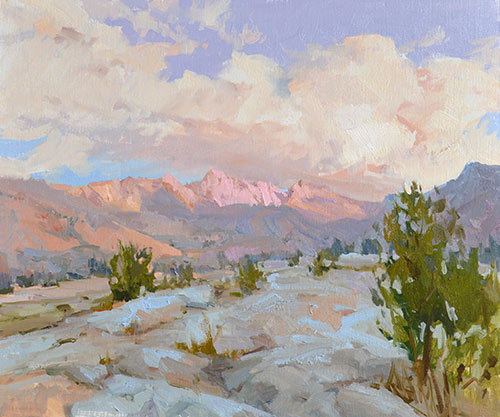
These rules are clear to those in the know, but federal cutbacks mean fewer rangers. As visitors, we are responsible for understanding the rules and following them. How often do you read the materials provided to you upon entry? Take the time, and observe all the signs in the area as well. Other than respecting the different rules, to an artist, does the designation difference really matter?
Here is one case where it might: The Great Smoky Mountain National Park, about three hours from where I live. This park was the most visited national park last year, with approximately twice as many visitors as Grand Canyon National Park (which came in second). The Smokies, as we call them, divide the Cherokee National Forest into two sections, north and south. Recently I was asked to exhibit work highlighting National Parks from all over the United States that I have had the great honor to paint.
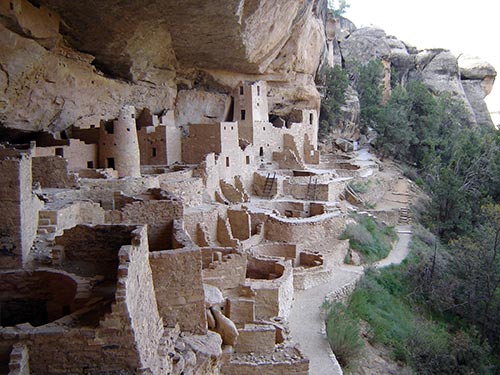
The blurred lines between parks, wilderness areas, and preserves led me to discover just how many of my paintings were painted while standing in an area with one particular designation while, in fact, I was painting a vista in a differently designated area. Not wanting to appear ignorant, it was important to make the distinctions between works from these areas apparent during the exhibition itself. I began digging through the National Parks Service site and a few other online lists. Soon I was reading about the real differences of these types of lands, who actually cares for them, and how fragile they are. (Two of the best resources I found for distinguishing one from the other are Mother Nature Network and High Peaks Alliance.) However, my point here is that it was very apparent that to me it had not been important to know the difference between these areas or exactly where I was standing in order to feel inspired to paint them. In fact, over half of the 30 pieces in the exhibition were actually painted in national wilderness areas, or in national forests.
Here’s my advice. Don’t sweat the designation title. Absolutely, celebrate our national parks and even take a little pride in what you may be doing to preserve them. Just don’t stop there. Less than half the states in the U.S. have official national parks, and there are important issues before us. Regardless of how each piece of land is designated, or how that might change in our lifetime, we are in danger of losing that of which we are the best stewards.
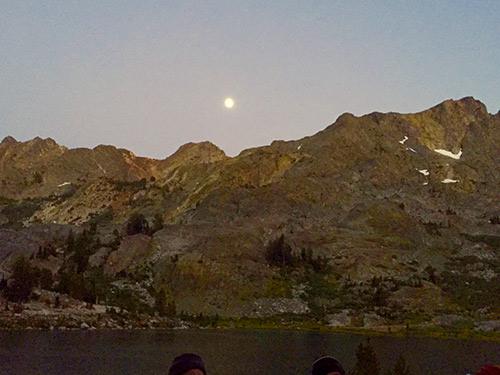
Over-tapping water resources, accidental introduction of invasive species, climate change, land degradation, air and noise pollution, littering, even the trampling of small vegetation (because you would really rather paint from over there) off-trail makes a huge impact on these once pristine lands. Environmental gases and climate change not only cause melting of the polar caps, but also cause increased colder and wetter temps in unexpected areas.
Mesa Verde National Park in Colorado experienced a wetter and cooler winter last year. That change meant new spring growth. Sounds great, right? But the summer drought brought higher-than-average temperatures, which in turn increased the threat of wildfires. Every day we make hundreds of personal decisions that can have an impact on nature. So even when we are not celebrating the parks or out there painting them, we should be thinking about how to save them. Just paying an entry fee or buying a pass is not enough.
Our parks service is in huge debt. There is not enough revenue to cover the billions of dollars needed to catch up on overdue maintenance projects. Recent ideas to offer corporate sponsors naming rights have sparked outrage. Can you image the signage with corporate logos and slogans throughout our parks? Commercials for Target Grand Canyon or Burger King Presents Old Faithful likely will not set well with visitors, but that could end up costing money in the end. In addition to just watering your lawn less, there are many well-known organizations with which you can partner to help.
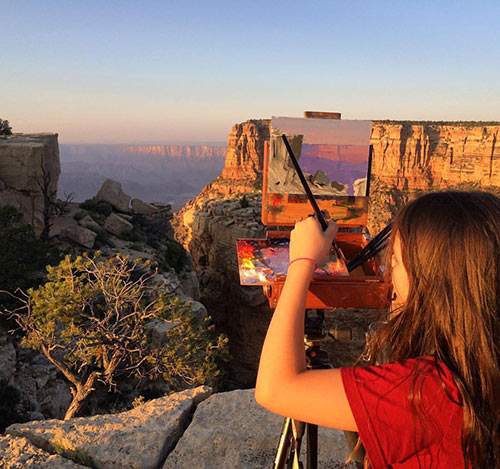
One of the most fulfilling ways to do that is through artist-in-residence programs that can be found in many protected or managed natural areas. As lovers of the landscape, and visual interpreters of its beauty and grandeur, nature reveals our inner souls. Why not take advantage of the wonderful opportunity to share your inner soul with others? More than 50 such residencies are available in the National Park System alone. Most residencies offer free lodging, and bring a more structured and affordable way for artists to interact with nature and visitors. Artists are typically asked to provide public programs and donate artwork to the park’s collection. They are also often encouraged to present public programs on their experiences once they return home. Application deadlines vary. Visit this site for more information or search “artist residencies USA” to find one that appeals to you.
Conservation and preservation of the land and passing along this beauty to future generations is crucial. By painting out there, even just being out there, I also believe we are preserving something else. You know what I mean if you have ever felt it. It’s like this enormous fount pouring over me, giving me with a sense of belonging to something bigger. Suddenly I am a part of our history and a part of our future, all at the same time, but it is within that split-second we call the present.
Maybe I’m actually working by comparing the value of the full moon to the value of a snow bank, but sometimes I am just absorbing. I am taking from nature all it has to offer, standing in the shadow of gigantic mountains, listening by the shore of rushing streams, or pausing in the early silence of sunrise. I experience the kind of peace much needed in my overloaded, overstimulated brain. It is self-preservation. My breathing deepens, and my heart rate slows. I paint more slowly, or take time to just sit and breathe it all in.
If only I could somehow return that which I’ve received. The peace I feel there lasts a long while, even after I am back to the phone and the computer and humanity. Like the Chickasaw in Oklahoma, we are tribes who gather in these places to “heal our souls.” I would like to believe our paintings bring that same sense of calm and healing to viewers who see them as well.


